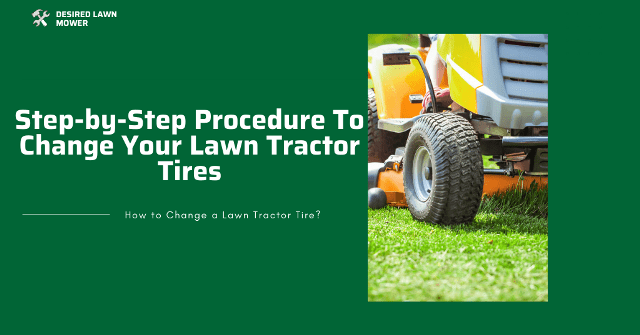Lawn tractor tires are not everlasting, even if we strongly wish they could be. If your tires have gone bald or stringy, perhaps they flatten more frequently than they should, it’s simply due for a change. Replacing the tires of a lawn tractor is easy when you have the right steps to follow, maybe with a sprinkle of determination too, but it’s never rocket science. A little unscrewing and yanking here and there with enough elbow grease, and voila!
In this article, I’ll be taking you through the easiest way to successfully replace your lawn tractor’s tire without a problem. The best way to begin is by gathering the right tools so that you don’t get destabilized halfway. Let’s get into it!
Tools You Will Need To Change Your Lawn Tractor’s Tire
- Gloves
- Lawn mower jack (view on Amazon)
- Tire spoon; if you’re a newbie, this looks like an oversized flat-head screwdriver without the handle (there’s rarely a handle). If this isn’t available, you can use a large screwdriver or a slim but strong metal rod.
- Hammer
- Flat head screwdriver
- Tire pressure gauge (view on Amazon)
- Valve stem puller
- Needle nose pliers
- Air compressor (view on Amazon)
- Some liquid soap
- Your entire strength and might

Changing The Tire Of Your Lawn Tractor Step-By-Step
1. Jack Up Your Lawn Tractor
First things first, use the lawn mower jack to lift the desired end with the tire you want to change off the ground. Ensure that your machine is stable to prevent it from tipping over or shifting when you’re in the process of removing the wheel.
2. Remove The Dust Cap On The wheel
The dust cap is directly in the middle of the rim. With your flat-head screwdriver in hand, poke the base of the cap till it lifts enough to be pried off. It’s similar to prying off the pressed-on lid of a metal tin. Also, take extra care on this step to avoid damaging the caps– they can be brittle especially if your lawn tractor is old.
3. Detach The Snap Ring
The snap ring helps to hold the shaft in place and is immediately behind the dust cap. It resembles a small metal semi-circle that is worn at the end of the shaft through a small opening. Using the needle nose pliers, pinch the snap ring and carefully slip it off the shaft. This component is also delicate and should be handled with care.
4. Peel Off the Washer
Once the snap ring is off, the washer follows suit with ease. Again with the needle nose pliers, nip the ring off the shaft. The washer resembles a full ring that is worn on the shaft and settles directly on the rim of the tire– it’s pretty easy to point it out after the snap ring.
5. Unfasten The Wheel From The Shaft
Now you can extract the tire wheel from the metal shaft and place it on a flat ground– it should slide off easily. Emphasis on ‘flat ground’ because what follows suit will need the flattest spot there is.
6. Deflate The Tire
Using your valve stem puller, unscrew the valve core to decompress the tire. Remember to be careful with this step because the pressure could shoot the valve onto you once the grip is loose.
7. Break the Bead
If you’re a newbie, you’re probably wondering what on earth this means. Compressed air forces the tires to stick to the rim after an eternity of running to and fro on the wheel. So, to remove the tire from the rim, you’d have to ‘unstick’ the unit– and this is where it gets serious.
Apply liquid soap around the line of the rim to ease the process and then using your hammer, hit on the area close to the rim. You might have to hit around a few times to loosen the seal. Then you can poke the tire spoon into the rim line and maneuver your way around to loosen the pair.
An alternative is to go cave mode; throw in your fists and knees if you must and press down continuously until the seal breaks and the tire holds loosely around the rim. Repeat this process on both sides of the tire.
8. Separate The Tire From The Rim
Using your tire spoon, poke the tool into the now open space between the tire and the rim, pin the tire down with a foot, and press down on the tire spoon till the rim pops out enough to be pulled. You can then grab the rim and wriggle it off the tire or vice versa– whichever way works for you.
9. Replace With The New Tire
Now, set the new tire on the floor and slip in the rim till it fits snugly into the center. Since both sides of the rim have to be outside of the tire, the need for a wrestling match arises. Flip the tire to the other side and press the sides around the center for the rim to pop out– this will take every extended limb and some serious determination to work.
Once you can spot the edge of the rim, use the tire spoon to poke around the edges till the tire is worn by the rim successfully.
10. Pump In Air
Using your air compressor, fill the tire with air exceeding the maximum pound per square inch to ensure that the bead is sealed properly around the rim. Afterward, you can deflate the tire to the recommended PSI tracking the process with your tire pressure gauge, and proceed to hoist it onto the shaft. This is also the point where the valve core is replaced to keep the air in.
11. Mount The Tire Onto The Shaft And Replace The Unplugged Items
Remember the washer, snap ring, and dust cap you previously removed? All you have to do is follow the step in reverse to properly fasten the components and complete the replacement process. Once this is done, you can then lower your machine and put your jack away. Also, get yourself a drink because you have definitely earned it!
What To Do If Your Tire Has Refused To Mount The Rim
The mounting process is usually the most challenging and will require you to throw in all fours. If you have reached this step and are having the worst time imaginable, don’t panic. Consider asking for extra hands. With two people in the picture, one person can press on the part of the tire that managed to go under the rim, and the other can wiggle the rest of the tire under the rim with the needed tools.
When this happens in some cases, it’s not your fault at all. There are many times that the tires are manufactured a little bit smaller than the required measurement or have shrunk during the packing process at the manufacturer’s. You can either reach out to customer service for the brand of tire you purchased and place your complaint or take your tire and rim dilemma to a repair person to help you complete the process; this wouldn’t cost much at all.
Conclusion
Although the steps are simple to follow, some components of the unit are delicate and require you to tread carefully, especially since you’d be using rather sharp tools and since your hands are highly involved. Well, except your skin is made of steel.
Changing a lawn tractor tire is a process that can be required at any time. It’s certainly not fun to do but is very much worth it to ensure a safe and pleasurable mowing experience. Good luck with your adventure!
